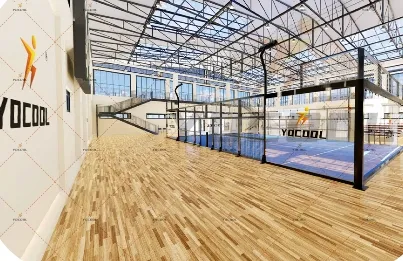

In the realm of modern recreational infrastructure, padel courts are no longer reserved solely for private clubs or luxury resorts. As demand surges worldwide, industrial and commercial developers are increasingly investing in the construction of padel courts for public parks, sports complexes, and multi-use recreational zones. These facilities not only boost community engagement but also offer a high return on investment thanks to the sport’s growing popularity. Building a professional-grade padel court involves more than installing nets and walls—it’s a complex, engineered process that considers surface material, drainage systems, fencing, and lighting integration.

When developing a large-scale recreational area, decision-makers must evaluate multiple aspects of the padel court cost to build, including materials, labor, land preparation, and infrastructure integration. Industrial installations often require durable surfaces that can handle heavy foot traffic, frequent use, and exposure to the elements. The padel court cost to build in such contexts varies based on whether indoor or outdoor configurations are selected, the quality of synthetic turf or acrylic surfacing used, and additional add-ons like access control systems, lighting towers, and acoustic barriers.
Choosing to invest in sports facilities means accounting for supporting infrastructure such as water drainage, concrete foundations, and electrical layouts. These elements significantly affect the cost to build padel court systems for municipalities, universities, and large-scale recreational operators. While a basic setup might seem affordable, industrial-grade courts often require reinforced steel framing, premium mesh fencing, and anti-vibration shock pads for acoustic dampening. These upgrades enhance the playing experience while reducing long-term maintenance costs—factors that justify the upfront cost to build padel court projects with industrial reliability in mind.
From surface materials to steel framing and enclosure systems, the paddle tennis court price depends heavily on selected features. Commercial developers often opt for galvanized metal structures and tempered glass panels that withstand wind loads and aggressive weather conditions. For venues expecting heavy usage, investing in long-lasting, UV-protected turf and high-performance LED lighting can raise the paddle tennis court price, but it also ensures minimal disruption over years of operation. Importantly, compliance with international standards—such as dimensions and rebound characteristics—adds to the final paddle tennis court price but opens the door for hosting tournaments or leasing space to training academies.
Enterprises and organizations aiming to build your own padel court should begin by identifying suitable ground conditions and ensuring the site can accommodate drainage, power supply, and structural loads. For corporate campuses, sports academies, or mixed-use facilities, the ability to build your own padel court also means customizing designs to fit spatial constraints while complying with regulatory guidelines. Pre-fabricated kits are available, but for large-scale or multi-court configurations, working with specialized contractors ensures structural precision and long-term performance. Whether using concrete slabs or engineered foundations, industrial projects require precise leveling and reinforcement to ensure even ball bounce and player safety.
While public installations are common, some enterprises opt to install a private padel court within residential developments, executive housing compounds, or private country clubs affiliated with their industrial ventures. These courts are typically designed with premium materials, tailored lighting layouts, and enhanced perimeter systems for both safety and privacy. A private padel court can be a strong differentiator for upscale real estate or employee wellness programs within tech parks and manufacturing campuses. Additionally, smart access systems and booking software further elevate the value and usability of such facilities.
Materials used in large-scale builds must meet industrial-grade durability. Acrylic surfaces offer weather resistance, while synthetic turf with silica infill ensures consistent play. Steel structures are often treated to prevent corrosion, especially in outdoor installations or humid climates. The right choice of materials extends court longevity and ensures compliance with international sports standards.
Industrial projects require more than a playable surface. Efficient lighting systems ensure nighttime usability, while engineered drainage keeps the court dry and safe after rain. These systems are vital to court usability, particularly in areas with variable weather or year-round demand. High-quality drainage channels and perimeter grading contribute significantly to performance and longevity.
Any industrial-grade facility aiming to host competitive events must comply with international specifications for padel court dimensions, materials, and safety measures. This ensures not only a better user experience but also eligibility for certification by sports federations—adding credibility and operational flexibility to the facility.
Q: What is the typical padel court cost to build for industrial-scale projects?
A: For industrial applications, the padel court cost to build generally ranges from $25,000 to $60,000 per court, depending on materials, lighting systems, and location-specific requirements.
Q: What infrastructure affects the cost to build padel court in commercial zones?
A: Key components like reinforced concrete slabs, lighting, fencing, and drainage systems significantly impact the total cost to build padel court facilities designed for heavy use.
Q: How is paddle tennis court price different for public vs. private sectors?
A: Public courts often use standardized materials for cost efficiency, while private installations focus more on customization and premium finishes—leading to variations in the paddle tennis court price.
Q: Can we build your own padel court using pre-fabricated kits for industrial areas?
A: Yes, modular kits are available but require proper site preparation and professional installation for industrial settings to meet safety and usage demands.
Q: Why is a private padel court valuable in industrial or executive spaces?
A: A private padel court enhances amenities, promotes wellness, and adds prestige to commercial or residential properties, making it a high-value asset for long-term use.
Starts with Strategic Padel Court Solutions
Sports Facilities with Innovative Padel Court Construction
Revolutionize Sports Facilities with Custom Padel Court Construction
Master Industrial Racquetball Performance with Professional Equipment
Industrial Expansion Begins with Strategic Padel Court Construction Investments
Construct Future-Ready Sports Facilities with Industrial-Grade Padel Courts